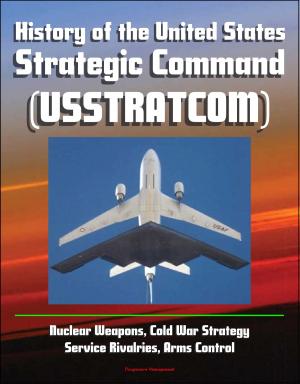The Rise of Air Mobility and Its Generals: Airlift, Air Refueling, and Aeromedical-Evacuation Missions, Mahan and the Purpose of Airpower, Geopolitical Changes, Support of Iraq and Afghanistan Wars
Nonfiction, History, Military, Aviation| Author: | Progressive Management | ISBN: | 9781370653492 |
| Publisher: | Progressive Management | Publication: | September 12, 2016 |
| Imprint: | Smashwords Edition | Language: | English |
| Author: | Progressive Management |
| ISBN: | 9781370653492 |
| Publisher: | Progressive Management |
| Publication: | September 12, 2016 |
| Imprint: | Smashwords Edition |
| Language: | English |
This excellent report, professionally converted for accurate flowing-text e-book format reproduction, examines the trend of mobility forces dominating air operations in the post-Cold War Era, and finds that as the United States moved from a strategy of containment toward engagement throughout the world, a corresponding shift occurred—away from contingencies demanding heavy concentrations of fighter and bomber planes and toward myriad, complex operations demanding mobility aircraft. This study also shows that as the number and importance of mobility-centric operations increased, the number of generals with mobility expertise also increased, especially at the most senior levels of the Air Force. The change in the composition of senior Air Force leaders is significant because it indicates that the Air Force is adapting to alterations in the geopolitical environment. It is important that we recognize and examine this change not only because it occurs infrequently within large bureaucratic organizations but also because it may signal a significant shift in the future direction of the Air Force.
Colonel Lenderman explores the increase in the number and influence of mobility generals in the late twentieth century and looks toward the future, presenting possible reasons why these generals will continue to rise or why their opportunities may be limited. She concludes by discussing the significance of this study as it pertains to the Air Force's development and the nation's security.
Chapter 1 of this paper explores the increase in the number and influence of mobility generals in the late twentieth century by presenting a theoretical foundation for their rise, based on Alfred Thayer Mahan's concept of sea power. Chapter 2 examines geopolitical changes in the post-Cold War era, which led to an increase in mobility operations. Chapter 3 reviews the unique mission expertise and worldview that air-mobility experts provide the nation. It also discusses organizational and cultural changes as well as Air Mobility Command's (AMC) leadership-development program, which prepares mobility leaders to assume increased responsibility. Chapter 4 looks toward the future, presenting possible reasons why mobility generals will continue to rise in prominence or why their opportunities may be limited. Chapter 5 concludes by discussing the study's significance as it pertains to the Air Force's development and the nation's security.
This excellent report, professionally converted for accurate flowing-text e-book format reproduction, examines the trend of mobility forces dominating air operations in the post-Cold War Era, and finds that as the United States moved from a strategy of containment toward engagement throughout the world, a corresponding shift occurred—away from contingencies demanding heavy concentrations of fighter and bomber planes and toward myriad, complex operations demanding mobility aircraft. This study also shows that as the number and importance of mobility-centric operations increased, the number of generals with mobility expertise also increased, especially at the most senior levels of the Air Force. The change in the composition of senior Air Force leaders is significant because it indicates that the Air Force is adapting to alterations in the geopolitical environment. It is important that we recognize and examine this change not only because it occurs infrequently within large bureaucratic organizations but also because it may signal a significant shift in the future direction of the Air Force.
Colonel Lenderman explores the increase in the number and influence of mobility generals in the late twentieth century and looks toward the future, presenting possible reasons why these generals will continue to rise or why their opportunities may be limited. She concludes by discussing the significance of this study as it pertains to the Air Force's development and the nation's security.
Chapter 1 of this paper explores the increase in the number and influence of mobility generals in the late twentieth century by presenting a theoretical foundation for their rise, based on Alfred Thayer Mahan's concept of sea power. Chapter 2 examines geopolitical changes in the post-Cold War era, which led to an increase in mobility operations. Chapter 3 reviews the unique mission expertise and worldview that air-mobility experts provide the nation. It also discusses organizational and cultural changes as well as Air Mobility Command's (AMC) leadership-development program, which prepares mobility leaders to assume increased responsibility. Chapter 4 looks toward the future, presenting possible reasons why mobility generals will continue to rise in prominence or why their opportunities may be limited. Chapter 5 concludes by discussing the study's significance as it pertains to the Air Force's development and the nation's security.















